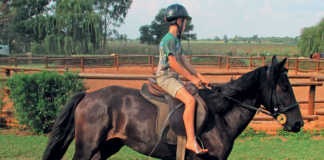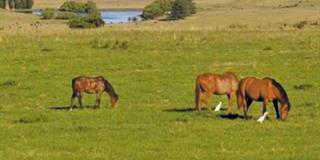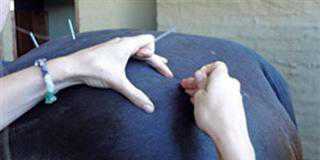Whenever you read an advertisement for a horse, look for the word “bombproof”. This kind of horse is worth his weight in gold! A bombproof horse is not only for your child but also for yourself, as everyone gets to that age where falling loses its appeal!“Bombproofing” is the process of training your horse – using a logical plan – to get used to different circumstances, noises and “scary “objects. It turns an ordinary horse into a more pleasurable, controllable, confident and safer ride.
In a nutshell, a truly unflappable horse.As with anything involving a horse, psychology is important. Not all horses are easy to train. Many factors need to be taken into account and we must remember that some horses haven’t had a good start in life, affecting their behaviour as adults. Then again, some horses are nervous by nature, while others are pushy and full of themselves. Your horse’s nature will determine the level of success and ease with which it can be trained.
Train compassionately
I believe, though, that any horse can be calmed and trained with the right amount of patience, understanding and time.Compassion is something all riders need to learn. No horse will learn if scared. Often horses are beaten or shouted into submission. This not only sends the essence of the horse into hiding, it makes it impossible for the horse to learn anything in the long run. The minute this horse is put under pressure its instinct to run will take over.Now, mention the word “dressage” and it’s usually the riders who run.
But basic schooling is very important for any horse – even a farm horse on track. Your horse must be obedient at all times. It’s essential that any horse can halt from any gait and back off your leg-aid and hand-aid. Lateral movement is also very important. When you’re riding your aids – hands, legs and seat – convey to your horse the task you’d like it to perform. Like any other language, both horse and rider must learn it.
Now down to the nuts and bolts. Once you’re sure your horse can walk, trot and canter from a leg aid, halt at a change of seat weight and move laterally off your leg, you’re ready to start helping him overcome his fear. Get an umbrella and show it to your horse. While being calm, slowly and safely expose your horse to the umbrella.
Once your horse has accepted the umbrella, you can move on to a piece of plastic on the ground. Allow your horse to have a good look at the plastic. Encourage him to walk over it calmly. Once this is done with ease you can saddle up and calmly walk over it on your horse. Often a horse will have a different opinion when you’re on the ground than when you’re on its back.
Most horses consider you an ally when you’re next to them facing the danger together. However, when you’re on its back, your horse might feel that it has to face the danger alone.The next step is a flag. Gently wave the flag near your horse. Never hit or shout at your horse. Repeat as often as you can. The more your horse is exposed to flags, balloons, umbrellas, plastic, bicycles, water, kid’s toys and odd-looking objects the faster it will gain the confidence to face them!













